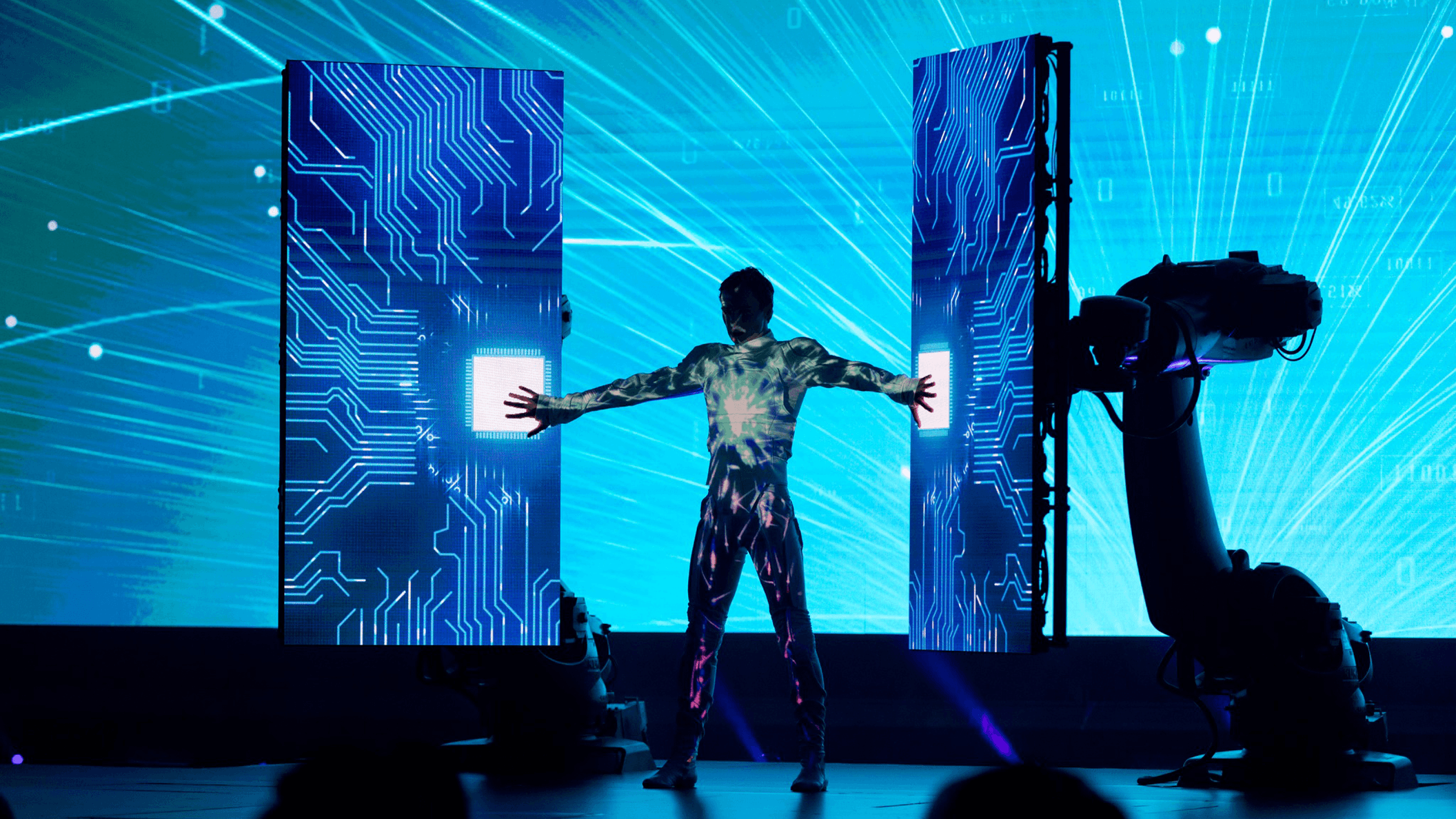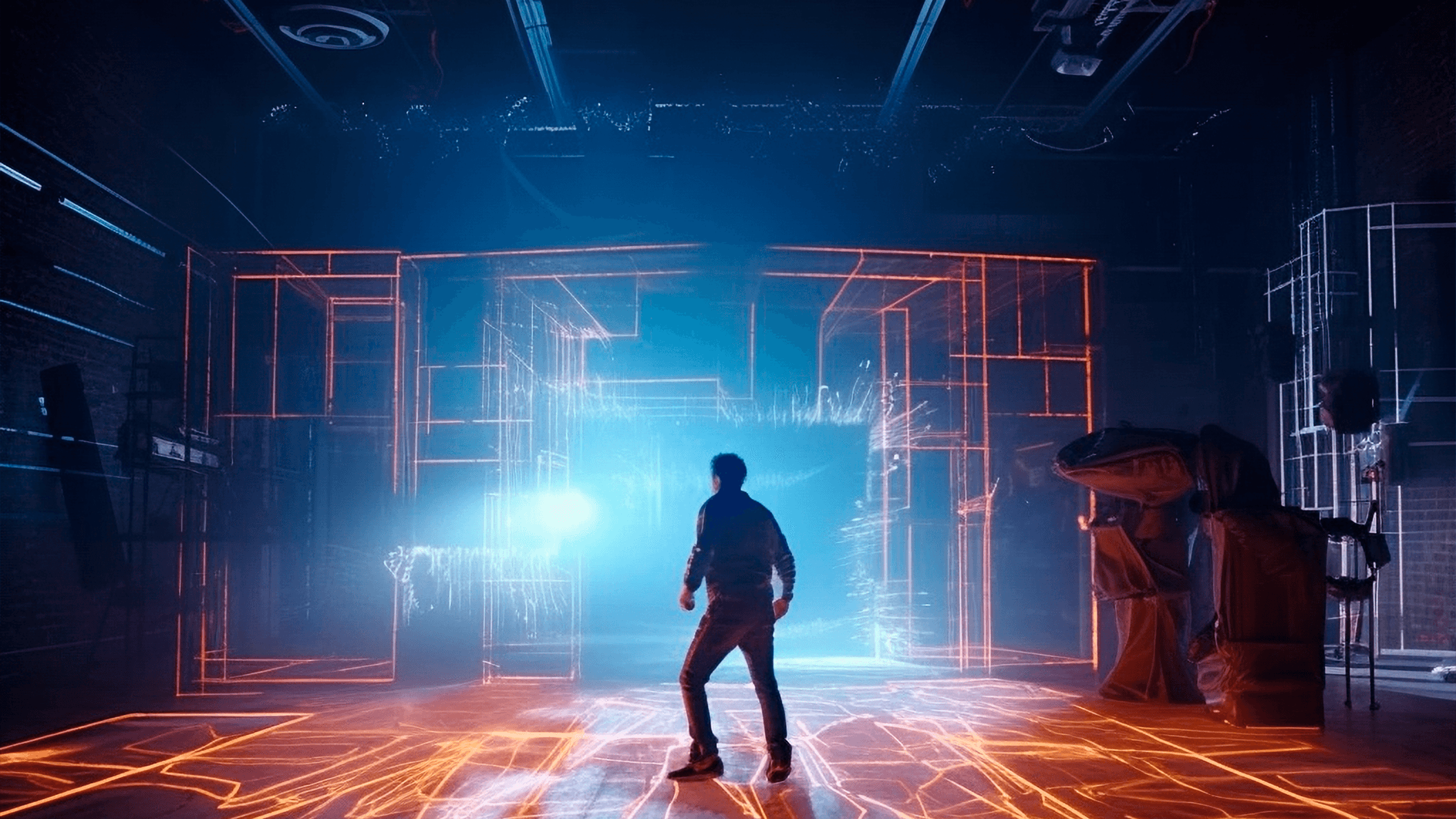
LIVE EVENTS
The magic of storytelling
Create a spectacular live event using a single Screenberry media server
Comfortable Show Sequencing
Screenberry provides flexibility in show programming by allowing users to utilize any number of media players, playlists, and timelines to achieve the desired results for a specific stage show. Additionally, you can mix different approaches to create unique and complex media compositions.

Accurate Synchronization of Backstage Services
Screenberry can control sound, light, video fixtures and devices using DMX, Art-Net, MIDI, OSC, as well as synchronize different scenarios using incoming or outgoing timecodes

Motion Tracking & Real-Time Effects
Screenberry supports professional stage object tracking systems such as BlackTrax and provides native support for professional stage graphics generators such as Notch and Touchdesigner. The user interface can be flexibly customized to control a specific show.

Explore all features
From show programming and show control to object tracking and real-time graphics

Streamline your setup using a single Screenberry server
Screenberry media server software is optimized for maximum efficiency, meaning you can get more done with less hardware. The highly efficient playback engine is capable of handling video up to 16 x 4K resolution using a single server without clusters.

Explore what you can create with Screenberry
Case StudiesFAQ
What are the essential elements of stage design?
When it comes to crafting memorable and impactful events, stage design comes front and center.
Whether it's event stage design that immerses attendees in a specific theme, theater stage design that sets the scene for compelling performances, fashion show stage design that adds glamor to runways, wedding stage design that encapsulates love stories, or church stage design that enhances spiritual experiences, certain essential elements remain crucial to ensuring a remarkable experience.
A unified theme
Successful stage design starts with a clear and resonant theme that aligns with the event's purpose. Each element should contribute to the theme's narrative, whether it's conveying a message, evoking emotions, or telling a story.
Strategic layout
The arrangement of props, performers, and equipment on stage is vital. An efficient layout ensures seamless movement and interactions, captivating the audience's attention from every angle. To ensure cohesive integration of all elements, specialized 3D stage design software can be employed.
Elevating lighting
Lighting is the stage's heartbeat, setting the mood and enhancing the ambiance. Well-executed lighting design adds depth and drama, guiding the audience's focus and emotions.
Visually captivating
Visual backdrops, projections, and multimedia content transform the stage into a canvas of creativity. High-quality imagery and dynamic visuals transport the audience into new dimensions.
Engagement through interactivity
Incorporating interactive elements bridges the gap between the stage and the audience. Touch screens, real-time data integration, and immersive experiences deepen engagement.
Reflecting identity
For corporate events, maintaining brand consistency is essential. A strong connection to the brand's identity creates a cohesive experience which resonates with attendees.
Attention to detail
Meticulous attention to detail, from props to fabrics, elevates the overall aesthetic. Even the smallest elements contribute to the immersive experience.
Adaptability
The ability to adapt to changes ensures a seamless performance. Real-time control and flexibility are crucial, guaranteeing the stage design remains responsive.
In conclusion, the elements of good stage design come together to create a comprehensive and captivating experience for the audience. From a purposeful theme and functional layout to innovative lighting, visuals, and interactivity, each component plays a crucial role in crafting unforgettable events. Meanwhile, the Screenberry media server will provide you with all the tools needed for orchestrating your stage elements.
How can multimedia elements enhance stage design?
Stage design is a captivating blend of artistry and technology. In recent years, the integration of multimedia elements has taken this discipline to new heights. From theatrical productions and concerts to corporate events and exhibitions, the infusion of multimedia components has transformed the way stages are conceptualized and experienced. Let’s explore the multifaceted impact of multimedia elements on the various applications of stage design.
1. Theatrical Productions
In theatrical productions, multimedia elements extend the possibilities of storytelling. Stunning projections, dynamic lighting, and synchronized audio effects enrich the narrative, transporting audiences to different worlds and eras. Whether it's a historical drama or a contemporary play, multimedia can create breathtaking backdrops, enhance emotional depth, and seamlessly transition through scenes, adding layers of engagement that traditional sets alone cannot achieve.
2. Concerts and music performances
Multimedia elements have revolutionized music performances by merging sound and visuals into an unforgettable symphony. From LED screens and projection mapping to intricate lighting designs, multimedia amplifies the musical journey. Concertgoers are immersed in a synchronized spectacle which complements the melodies, turning live shows into multisensory extravaganzas that resonate long after the final note.
3. Corporate events and presentations
In the corporate realm, multimedia elements have redefined presentations. With the aid of interactive displays, holographic projections, and augmented reality, speakers can communicate complex ideas with clarity and impact. Whether it's a product launch or a keynote address, multimedia enhances engagement, leaving a lasting impression on attendees while facilitating effective communication.
4. Fashion shows and runways
Multimedia has revitalized the fashion industry by transforming runway shows into artistic showcases. Projection mapping and innovative lighting designs turn models into living canvases. The fusion of fashion and technology adds an avant-garde dimension to presentations, redefining the boundaries of creativity.
The integration of multimedia elements has ushered in a new era of stage design, reshaping the landscape of various applications. As technology continues to advance, the potential for innovative stage design remains boundless, promising audiences even more breathtaking and unforgettable experiences in the years to come.
How can you set up successful stage design?
Main components of event stage design
Every stage design consists of essential elements that contribute to its overall success. These components include:
Screens: The screen serves as the primary focus point where visuals, messages, and images are shown.
Lighting: The correct lighting setup can not only make your stage more visible but also set the mood, highlight key areas, and support the event's theme.
Technology: This includes sound systems, projectors, LED screens, and interactive technology.
Furniture: Depending on the type of event, furniture can range from a simple podium to comfortable seating arrangements.
Set Decor and Props: These can add depth to your stage design, providing visual interest and supporting the theme of the event.
Steps to Proper Stage Setup
Make a Stage Plot: This is a visual representation of where each element of the stage will be positioned. Whether you're sketching a simple layout or crafting a 3D rendering for more intricate stage set design, the stage plotting process forms the backbone of a harmonious stage setup.
Make Sound & Lighting Plots: Here you'll outline where the sound system, speakers, microphones, and lights will be positioned throughout the venue. Careful planning in this step can significantly improve the audio-visual experience for the audience. And with the right stage lighting design, you can enhance the ambiance, spotlight key moments, and ensure the mood aligns with the event's theme.
Mark the Center of the Stage: Mark the center of the stage to provide a reference point for setting up props, furniture, and equipment. This crucial element of stage background design helps maintain balance, symmetry, and focus on the main attraction of the performance or presentation.
Establish Platforms and Elevations: These platforms elevate performers or speakers and help improve visibility for the audience. In the case of outdoor stage design, these platforms must be sturdy and safe in different weather conditions.
Arrange Seatings and Stands: Arrange these according to your stage plot. The seating layout is part of the stage set design, and should ensure smooth transitions between different segments of the event.
Have a Plan for Gear Coming off Stage During the Event: Make sure there's a designated area where items removed from the stage can be safely stored. This logistical detail, though often overlooked, is key to a seamless performance or presentation and contributes to successful stage design.
The setup for stage design greatly depends on the theme and type of the event, as well as the available budget.
Why are media servers a must for stage shows?
Incorporating a media server into stage design offers numerous benefits that redefine live performances. This technological tool is instrumental in producing captivating shows that resonate with audiences on multiple levels.
Central to its advantage is the ability to generate dynamic visuals that breathe life into performances. From videos to animations, a media server introduces a visual dimension that engages and mesmerizes the audience. This dynamicity contributes to an immersive atmosphere, fusing visuals with audio and lighting cues to craft a seamless experience that evokes the intended mood or theme.
Crucially, media servers provide real-time control over visual elements, allowing for spontaneous adjustments during performances. This capability empowers designers to synchronize various components, creating a harmonious production that wows the audience. Projection mapping is another highlight, enabling intricate visuals to be mapped precisely onto complex surfaces or structures, transforming them into captivating canvases.
The server's role in content management cannot be overstated. It serves as a centralized hub for organizing, storing, and retrieving visual assets, and for streamlining the workflow during rehearsals and live acts. This efficiency extends to revisions; media servers facilitate quick adjustments in rehearsals, ensuring that the final presentation aligns with the desired vision.
Moreover, the versatility of media servers encourages creative exploration. Designers can experiment with diverse concepts and effects, enriching the stage design with innovative ideas. The tool's interactive capabilities bring an extra layer of engagement, allowing real-time interactions, audience-driven visuals, and even integration with social media.
Screenberry has been designed as an effective tool for orchestrating all the multimedia elements of a stage show. It can playback content in extreme resolutions from a single server. The system of virtual outputs allows for the flexible redirection of signals to varying screens and screen groups, facilitating real-time mixing.
With Screenberry, you can mix pre-rendered content and real-time effects. It smoothly integrates with popular real-time software like Notch, Touch Designer, and Unreal Engine, while also supporting professional stage object tracking systems like Black Trax.
Screenberry provides various ways of content management and compositing, including classical playlists and timelines, as well as matrix playlists, or a flexible combination therein. With its easy and adaptable functionality with layers, timecodes, and alpha channels, it allows users to control a show of any complexity.
Screenberry can control stage equipment using DMX, Art-Net, MIDI, OSC protocols, or with the help of timecodes.

Let's find the right solution for your project
Get in touch
